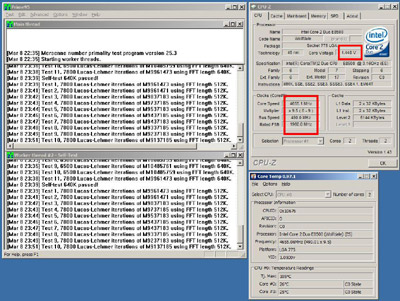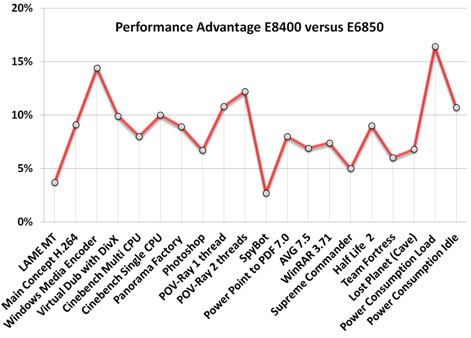|
|
|
|
|
Intel E8000 "Wolfdale" Dual-Core Processors |
|
Join the community - in the OCAU Forums!
|
Power, Heat, Overclocking, Summary and Final Words
POWER CONSUMPTION AND HEAT DISSIPATION
The E8000 series is specified with a TDP of 65 Watt. This is unchanged from the E6000 series, which is somehow surprising considering the power and heat reducing technology Intel has implemented in the new core. They argue that a “higher performance is achieved at the same TDP”. Nonetheless, we believe that Intel has set the TDP of 65 Watt very conservatively. The new 45nm core runs with lower voltage and should consequently dissipate less heat. CPU-Z shows the E8500 idling with Speedstep enabled at around 1.10v. Under full load we observed voltage readings between 1.20v and 1.22v. The corresponding values for an E6850 are around 1.20v at idle state, and 1.35v under load. Speedstep kicks in when the system is idling or running with very low load. It drops the multiplier to 6x and the processor frequency to 6x333 MHz = 2000 MHz. At the same time the core voltage is dynamically lowered down.
The wattage monitoring unit we used reads power consumption at the wall plug. The values shown in the “System Power” chart represent therefore total system consumption, including video card, chipset, RAM and peripherals. In idle state our E8500 based test system consumed 159 Watt; this is around 11% less than the E6850 was consuming. The difference is even bigger under full load when Prime95 is running: The E8500 system is drawing 188 Watt; the E6850 was drawing 225 Watt. This is quite a big difference of 16%. In fact, an E8500 under full load is using less power than an AMD 6400+ when idling. With an estimated around 700 million PC in use worldwide the amount of wasted electricity by “idling” desktops and workstations has become a matter of concern. It is estimated the world spends up to US$ 7 billion dollars every year powering inactive computers and producing this way 45 million tons of CO2. Cutting down PC power consumption in idle state is therefore important. Already Intel’s E6000 series was the most power efficient dual-core CPU available. The combination of better clock-by-clock performance with at the same time substantially reduced power consumption makes the Penryn processor family even more power-efficient. Reduced power consumption does not only lower the utility bill, but also provides for a more “silent” computing. Because a Penryn processor dissipates less heat, it needs a less powerful, hence quieter fan for cooling. The E8400 was running under load between 8C to 10C cooler than an E6580.

OVERCLOCKING
As usual for an Intel CPU, the E8000 series processor has to be overclocked by increasing the front-side bus frequency. The multiplier remains “upward” locked. Currently only the quad-core “Extreme Edition” comes with an unlocked multiplier. Intel will not release an “Extreme Edition” for the E8000 series. No such version was available for the E6000 series either. The 8500 we used for this review was an unlocked engineering sample. That means it allows, unlike normal retail CPUs, overclocking the core frequency by raising the multiplier. However in order to simulate the overclocking situation people will experience with a retail sample, we did not use this function.
Before we present E8000 results, we would like to come back to our QX960 review. This processor went with watercooling stable up from 3000 MHz to 4300 MHz. It required though a massive voltage increase from 1.325v default to 1.55v to achieve this. The overclocking headroom with the QX9650 was around 200 MHz better than what we achieved with a previous generation Q6850 “Kentsfield” processor. In general, dual-core CPU overclock better than quad-cores. With all this in mind, we expected our E8500 test sample to be at least as good as the QX9650, and substantially better than an E6580.
We used an Intel E6000 series retail HSF, because our engineering sample came without a HSF. Stability was tested with a 60-minute run of the Prime95 “torture” run. Initially we tried to identify the minimum voltage required to run the default frequency of 3160 MHz. The test sample did so at around 1.15 volt. This is around 10% below the specified default voltage of 1.225v. The next step was testing the maximum possible core frequency at default voltage. And here came the first surprise: The E8500 sample did run stable at default voltage close to 3900 MHz. That’s a quite amazing 740 MHz (almost 25%) on-top of default frequency. It’s most certainly the impact of the much reduced power consumption and current leakage that comes with the new 45nm parts.
From this result we could already see that the E8500 would run with additional voltage substantially above 4000 MHz. And that it did. With a BIOS voltage setting of 1.425v resulting in an actual voltage of around 1.385v, and additional MCH voltage as well, we could push the E8500 up to 9.5 x 452 MHz = 4294 MHz. This was still with the retail HSF. The CPU temperature was above 70C when running Prime95. This is hot, but still acceptable, as we were still using a “lowly” retail heatsink. It seems the E8000 series offers some very substantial improvement in overclocking. Even with additional voltage and high-end aircooling, an E6000 processor is usually maxing out below 4 GHz with air-cooling. We think that most C0 stepping E8000 of the currently retailing batches will make it at least to 4 GHz with aircooling and probably above with a quality HSF.
At this stage we changed to water cooling. We used a “homemade” water set-up with an Apogee GTX waterblock, LAING D5 pump, 3x120mm radiator, and 10mm tubing. For good measure the water was cooled down with crushed ice in and around the reservoir. After various trials making use of the plethora of P5K BIOS overclocking settings, we settled for 9.5x490 MHz = 4655 MHz. With a processor voltage of 1.525 volt, resulting in an actual load voltage of 1.48v, the E8500 could withstand the mandatory 1-hour Prime95 torture test. When comparing overclocking voltages between E8000 and E6000 processors, the reader should keep in mind that they are specified with different default voltages. The 45nm processors run with a default voltage of 1.225v and the 65nm processors of 1.325v. The required voltage to get the E8500 stable at 4655 MHz was therefore a hefty 30% above default. Such voltage level cannot be recommended for day-to-day use. It will substantially shorten processor life through increased electro-migration. This process is the gradual displacement of the metal atoms of a conductor as a result of the current flowing through it. It’s an unavoidable process at any rate, but it will accelerate with higher voltages.

4655MHz Prime stable
It seems our E8000 overclocking results are not exceptional. We have seen similar results reported in our Intel forum and other enthusiast sites. For example Dinos22 in this thread is enjoying 5675MHz from his E8500. As already mentioned above, the QX9650 sample in our earlier 45nm Yorkfield review ended up with a retail heatsink at 3000@3600 MHz and with watercooling at 4300 MHz. It seems the 45nm based dual core parts are not only overclocking better than the E6000 series but also slightly better than their quad-core cousins. The general impression is that 45nm quad-core CPU hit a FSB "wall" at around 470 to 480MHz. As demonstrated, such “wall” does not exist for E8000 processors. They seem to have a much higher FSB ceiling.
We repeated a few of our benchmarks to see if performance is scaling up in line with frequency. And it does! At 4655 MHz we recorded impressive performance gains: The multi-CPU score in Cinebench R10 went up 41%, compressing a 90 MB file with WinRAR was done 46% faster, and when gaming with “Lost Planet” we got 38% more frames per second compared with the default speed of 3160 MHz. It seems E8000 performance is scaling up nicely with frequency. This is not always the case, because due to increasing overheads and bottlenecks in the micro-architecture the impact of higher core frequencies when overclocking the front-side bus is often “flattening” out. However, it seems in case of the E8000 the 50% enlarged L2 cache has enough “reserves” to efficiently handle the greater amount of data to be processed at higher frequencies without degrading performance.
SUMMARY and FINAL WORDS
Applications and games are benefitting to a different extent from the various small improvements to Wolfdale’s micro-architecture and 50% larger L2 cache. The E8000 performance advantage in gaming is between 5~8% depending on the game. This is a very respectable improvement, but it’s below the threshold where you actually notice a difference. Wolfdale truly excels in video encoding: The E8000 series is more than 30% faster if SSE4.1 instructions are utilized. But even when encoding only with SSE2 instructions, which will be the standard case for some time to come, an E8400 still outruns an E6850 by up to 15%. In 3D-rendering and image processing an E8000 processor is up to 12% faster. For such tasks a Penryn based processor makes definitely a noticeable difference. Day-to-day desktop jobs like virus scanning or file compression are completed between 3% and 10% faster. The E8500 has dethroned the E6850 as the fastest dual-core desktop processor. Intel has topped its own performance leader with an even faster processor.

We cannot stress enough the benefits of Penryn’s reduced power consumption. In the grand scheme of things, 18% lower power consumption matters more than 10 additional frames per second or 10% shaved off encoding time. Most users will appreciate a lower utility bill and a more silent running system, and the environment reduced CO2 emissions. And last but not least there is the massive overclocking headroom to mention. Bottom-line: The E8000 series is in each and every aspect better than E6000.
That brings us to pricing. Intel has positioned the E8000 family in the same price brackets as the E6000 CPUs they are going to replace. This is apparent by the published prices Intel is charging for 1K quantities to their first tier distributors. Apparently demand in particular for the E8200 and E8400 varieties is currently far greater than supply. It seems some vendors and distributors are trying to profiteer from this situation by asking for far higher prices than a few weeks ago. The E8400 for example was at the beginning of March listed by some Australian vendors at close to 400 AUD. A few weeks earlier an E8400 was sold for 320$. On the other hand Intel has been ramping up 45nm production for almost half a year now. Intel CEO Otellini has stated at the beginning of March that their fabs have already shipped more than 4 million 45nmm processors since November 2007 and are currently putting out 100,000 such processors a day. The supply problem should therefore be solved in the near future. At retail prices of around 250 AUD for an E8200 and 320 AUD for an E8400, these processors do not cost more than previous generation E6000 CPUs but offer better performance, lower power consumption, and better overclocking potential. Nonetheless we would like to mention that the Penryn family of E8000 and Q9000 processors is only a transitional product. Intel is preparing a completely new micro-architecture, a new socket, and new chipsets for the beginning of 2009. In less than 10 months we will have a new, probably even more powerful processor and chipset generation available. For the time being we recommend the 45nm based E8000 dual-core and Q9000 quad-core series without reservation. These products offer excellent value for the mentioned prices, and are currently without a competitor, when it comes to performance.
|
|
Advertisement:
All original content copyright James Rolfe.
All rights reserved. No reproduction allowed without written permission.
Interested in advertising on OCAU? Contact us for info.
|

|


